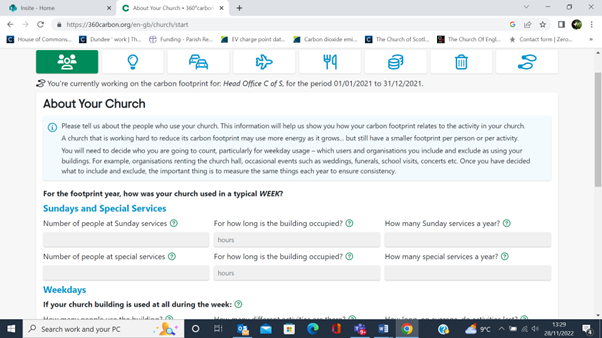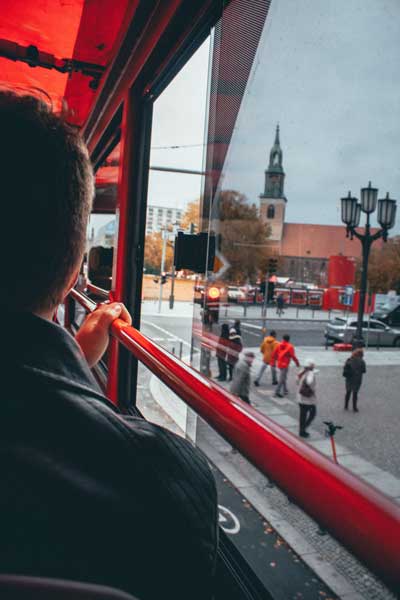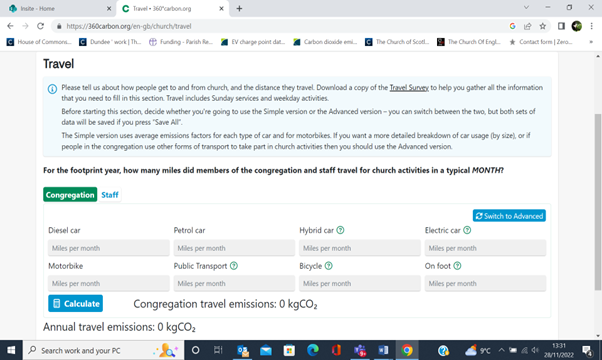Travel
Measuring the carbon footprint of travel to and from your congregation's buildings, as well as travel on behalf of congregational business.
Travel to and from your congregation's buildings
What's the issue?

In 2018, 35.6% of Scotland's greenhouse gas emissions were produced by transport, according to Transport for Scotland's Carbon Account 2020, and 39% of this was from cars. Transport is the single biggest source of greenhouse gases in Scotland, according to Scottish Government figures.
How we travel makes a big impact. Yet, travel is essential for our day-to-day activities and for our congregations, especially in rural communities or in unions where people may live further from their place of worship. By gathering information on how far we travel and what methods we use, we can start to plan how to support and encourage people to travel more sustainably.
Measure
What information can we collect on transport?
To get a sense of our emissions from transport, it's useful to ask:
- How many miles are travelled each month by the congregation's staff, Minister and volunteers on congregational business? By what means of transport?.
- How many miles are travelled each month by congregation members and others travelling to use your buildings, and by what mode of transport? Unlike Scope 1, these journeys are not entirely within the control of the congregation, but as they are made to your buildings, you still have some responsibility for them. These journeys are known as "Scope 2". Information about Scope 1 and Scope 2 should be counted separately.
It's useful to find out about modes of transport, including different forms of public transport, motorbike and electric bicycle, and to consider the types of fuel cars use (i.e. diesel, petrol, hybrid, electric). Each mode of transport has different average emissions.
"Active travel," such as walking and cycling, don't emit any greenhouse gases, but for many people this isn't an option and transport is essential. The purpose of the data collection is to help us think about ways to reduce our use of individual transport and make changes that would reduce the impact of our travel as a congregation and community.
How can we collect this information?
Climate Stewards' travel survey provides a useful spreadsheet format for collecting information on how we travel. This can be downloaded from their travel survey page. Please see below for instructions on how to sign up to Climate Stewards.
Suggestions for collecting data for the travel survey:
Try to collect responses from a sample of people travelling to your church buildings. For example, a group of people attending church services, discussion groups run by the congregation, and then some from each social group, e.g. the Boys' Brigade or Brownies, older youth groups and older people's activities. If your congregation holds services in different sanctuaries on different days, it would be helpful to collect data from people coming to worship at each sanctuary. Make a list of each activity meeting regularly in the buildings and decide how best to engage with the people attending. The Boys' Brigade may demand different tactics to The Guild, for example. If you already know more or less how many people use your building monthly, those figures could be used to work out what percentage of the total you've surveyed.
If respondents aren't sure of distances, ask for the name of the area or the first half of the post code and then use Google to find out the distance by road to your buildings. Ask respondents to include all their monthly travel to the church buildings on one survey form. If people share a car, only the driver need add it to their survey answers, and enter the number of passengers in a separate column on the form.
The data from the travel surveys can be entered into the Climate Stewards page on transport to calculate carbon emissions. The information needs to be recorded under two headings for the Climate Stewards. One heading is "congregation" and includes all of the people coming to the buildings except for Church staff and volunteers travelling for congregation business. They come under the "staff" category on the Climate Stewards website, and the data for this group can be entered separately.
Depending on the members of the congregation or group, you could email the spreadsheet with instructions on how to fill it in, or use social media. Alternatively, you could gather travel and transport information at a meeting or service by asking people in person.
How do we calculate the greenhouse gas emissions?
Register your congregation on the Climate Stewards website by clicking the "carbon calculators" option and then click the "360 Carbon" button on the "Small Organisations" tab. Go to "Start a new carbon footprint" to reach the following page:

You'll need to enter some information about your congregation and set the period you wish to calculate emissions for. There is a Travel section (the cars icon at the top of the screen) where you can enter the data you've gathered from your transport survey. Please see below.
The website has a separate page for staff and congregations. The staff page should contain information about anyone doing work for the congregation, including volunteers. The congregation page should include information about regular visitors and users of your buildings, both congregation members and those using the buildings for community purposes. Input the figures you have collected from each survey into these pages and press "calculate". This will give you emission figures for your staff (congregation business travel – Scope 1) and your congregation (travel of people who come to your buildings – Scope 2)
Just as useful as the overall totals on greenhouse gas emissions will be the information on trends and behaviour. How many people are using public transport, or active travel, which is usually defined as walking, wheeling or cycling? Who is most likely to drive? Are many people driving to the same event from the same place?
Asking questions of this data and sharing it with the congregation and users may help people to start thinking of ways to share journeys or make better use of public transport or active travel. Could you share the results with your congregation, perhaps on Facebook or in a newsletter? There's no need to collect personal data for this survey, so the results should be anonymous.
Travel Expense sheets that calculate greenhouse gas emissions per mile can be found online. That would give you a monthly update for staff emissions without regularly inputting the data to 360 Carbon.
Flying
What's the issue?

Domestic flights and other types of aviation accounted for 15% of Scotland's transport carbon emissions in 2018, while train travel accounted for 1.1%. Flying has increased by nearly 60% between 1990 and 2018, according to Transport for Scotland's Carbon Account 2020. Although flying can be a lifeline in some rural and island locations, where public transport is often limited, on the whole, travel by train or bus travel will save a lot of carbon emissions.
Is air travel becoming more environmentally friendly?
Many airlines now offer a voluntary or mandatory carbon offset levy designed to make your flight carbon neutral. This money is not spent on reducing the amount of carbon emitted by the aeroplane, but usually invested in a nature-based scheme such as planting trees to sequester carbon from the atmosphere.
It's not clear how effective these schemes really are in meeting their aim of eliminating carbon from the atmosphere, to make up for the carbon that air travel produces. As a Euronews.green article states: "While a new forest may sequester a valuable amount of CO2 in the next 50 years, it won't help us meet the Paris Agreement's carbon neutrality goal in under eight years."
Efforts to develop greener flying fuelled by hydrogen or electricity are underway and may be available within a few years for short-haul flights. Pilot flights in Orkney using hydrogen fuel may be available by late 2023.
How can we measure the carbon emissions of air travel?
There is a page on the Carbon 360 website where you can enter up to 20 flights and the emissions will be calculated.
Reduce
Travel is Scotland's biggest single source of carbon emissions, and the Scottish Government have launched a range of incentives and schemes to help us to reduce our use of petrol vehicles and travel more actively and collectively.
Our carbon emissions for travel can be divided into two scopes:
- Scope 1: Travel by the congregation's staff, Minister and volunteers on congregation business
- Scope 2: Everyone else traveling to the congregation's buildings for activities. That includes members of the congregation and people coming for other regular activities which take place there, such as Brownies, lunch clubs, playgroups, etc.
If you have done some travel surveys as described in the Measure section, you'll have some information about how people tend to travel to your buildings which can help you decide which of the following suggestions might be worth trying in your community. The surveys may also help you decide which groups using your buildings need to be involved.
As a congregation you may not have much direct control over how people travel whether they are on church business or are members of the public coming to your buildings, but there are ways to make it easier for people to use lower-emission travel options and to spread awareness and encourage people to travel in ways that use less carbon.
Public transport
Public transport is crucial to reducing Scotland's carbon emissions. According to the Scottish Government's NetZero Nation website replacing car journeys with public transport can help reduce carbon emissions by 42% if using the bus and 73% if using the train.
Encouraging public transport use

- Schedule services and events to fit with public transport timetables. For example, if the building is on a bus route, is a bus due to arrive in good time for the event? Will people have to wait a long time to get a bus home at the end?
- Ensure that the congregation and regular visitors are aware of the public transport connections available, for example, by publicising timetables on the website or Facebook page, or on a noticeboard
- For route planning, the Traveline Scotland app is helpful. Many cities around Scotland have apps that provide local transport information.
- Remind your community that everyone under 22 living in Scotland can travel by bus for free. The Young Scot website has details of how to apply for the free bus pass, with parents and guardians applying on behalf of children from 5-15. Under 5s travel free without a pass.
- Support the Faith Leaders Campaign for free bus travel for refugees and asylum seekers. More information is on the Church website here.
- If the building is close to a train station, remind your community of the range of people who can travel on Scotrail trains at a discount. Rail cards are available for families, over 60s, under 30s, permanent residents of the Highlands, people with disabilities and more. Details of passes and how to apply are available on the Scotrail website. There is also a Scotrail app to plan routes, receive live updates and buy tickets online.
- Scotrail has cancelled peak time charges for a six-month trial period, starting October 2023.
Car or ride sharing
If active travel or public transport are less viable options, sharing cars may be a possibility.
- Can your congregation facilitate informal lift sharing, where people offer lifts to others in their neighbourhood (subject to safeguarding issues that may arise)?
- There are formal schemes which individuals can join to find or offer lifts locally online. CoMoUK's website has more information and links to ride (lift)-sharing schemes.
- Car share schemes are a way to rent a car for a specific trip, either regularly or as a one-off, enabling a driver to make use of a locally available vehicle for a fixed fee, which is usually considerably less than a car hire fee. CoMoUK has more information and a map to find car share schemes near you. Some car shares will also be electric vehicles or hybrid.
Electric cars
By 2030 the Scottish Government intends to phase out the sale of new non-electric cars and vans. Electric (EV) cars are a much lower-carbon option than petrol cars as, like electric bikes, they can be charged from the national grid which is largely decarbonised in Scotland. Hybrid cars offer the option to use petrol as well as electricity if the electric charge runs out. This webinar on EV vehicles and charging, organised by the Church of England and featuring Cumbria Action for Sustainability, describes the environmental benefits of EV cars over petrol vehicles.
Access to electric vehicles and charge points
- Although cheaper to run over their lifetime than petrol cars, EVs can be more expensive to buy up front. To reduce this cost, there is an employers' salary sacrifice scheme to help employees access an electric car. Congregations that employ staff locally could explore this option. This may now apply to second-hand as well as new EVs. While these tend not to have as much range as newer EV cars, they could be an option worth exploring for town use.
- If staff or community members are interested in getting an electric vehicle, the Energy Saving Trust website has detailed independent information about EV cars and a guide to choosing a car
- Home Energy Scotland provide grants in some geographical areas of up to £300 to install a charge point in a home or in a manse. There are also some interest-free loans to buy electric cars. The public are advised to free phone 0808 808 2282 to speak to an advisor about what help is available.
- There is a national push to install more publicly accessible EV charge points, as many homes do not have the off-street parking required for a car charger. The ChargePlace Scotland live map can be used to find publicly available charge points nationally.
More ways to encourage people in your community to use electric vehicles
If your congregation wants to take further action to encourage the community to use electric vehicles to reduce carbon, here are some ideas:
- St Madoes and Kinfauns Parish Church's Madoch Centre in Perthshire runs an electric minibus which is charged, currently for free, at a public EV charge point in the church grounds. The minibus is used as a community transport service, with volunteer drivers enabling vulnerable people to access the church for a variety of activities.
- Project Eve is a pilot scheme to help churches install electric charge points for public use in church grounds. More information on this scheme will be available soon.
Active Travel: low-carbon or no-carbon travel

Active Travel includes riding a bike, walking, wheeling a wheelchair etc. Electric bikes count too, as electrical power in Scotland is now mostly decarbonised. As well as enhancing health and wellbeing, active travel can save on fares, petrol and parking costs and reduce congestion and pollution in your grounds and the neighbouring area.
While active travel depends on individuals' capacity and motivation, it's worth remembering that over half the journeys made in Scotland are under 5km (3.1 miles) according to the Scottish Government's Active Travel advice, and more of these could be actively travelled.
Encouraging more people to walk to your buildings
- Initiatives such as the "10,000 steps a day challenge" could be used to encourage people to walk to your buildings, using a phone app to monitor how many steps they take in a day. As an example, the charity Heart UK runs an annual 10,000 step challenge for its supporters over the course of a month.
- Walking buses are promoted as a way for groups of children to get safely to primary school. These involve two adults accompanying a group of children who join the "bus" near their home and walk with it to a shared destination. If it works to get to school, would it work for a group of children coming to Brownies, Beavers etc? Aberdeenshire Council has a guide to walking buses that may help you decide if a walking bus is feasible for groups coming to your buildings.
- Adults or young people who live near one another might enjoy walking if they can do it together. This could be facilitated informally in any group that uses your buildings.
Encouraging cycling
- Ensure there is a safe space allocated in your grounds for people to lock and leave their bikes
- To encourage congregation members and others coming to the building to try cycling, you could share the tips on the Net Zero Nation Scotland website for getting started
- Falkirk Active Travel have produced a couch-to-cycle app to help people get on their bike
- 75% of us live within two miles of a cycle route. To find the best cycle route to the building, cyclists can use CycleStreet's interactive map, which includes options such as fastest or quietest route and calculates the gradient and the amount of carbon saved. For the National Cycle Routes Network, information is available on the Sustrans website
- Access to bikes: loans, cheap repairs and bike share schemes:
- The Church of Scotland provides a salary sacrifice scheme for staff, Ministers and MDS staff employed centrally to buy a bike and necessary equipment by paying in instalments from their pre-tax salary. Contact the Human Resources Department of the Central Services Committee for more information about the scheme.
- The Scottish Government provide interest-free loans to buy an electric bike, including a cargo bike, which can be used for delivering goods or to carry young children. Details on how to apply are available on the Net Zero Nation Scotland website.
- Free or low-cost repairs for those on a low income are available through the Scotland Cycle Repair Scheme. There is a map on the webpage to find your nearest participating shop or mechanic, which includes at least one Church of Scotland parish church.
- Freecycle is a website offering free items from the public and may be helpful for sourcing a bike or related equipment
- Bike share schemes can be great for people who don't have a bike and want to give it a try, or who want to cycle without the expense of buying or storing a bike. CoMoUk's Travel Better Tool explains how bike shares work and has a map showing where bike share schemes run in Scotland. Electric bikes are included in some bike share schemes.
More ways to encourage active travel
If your congregation wants to invest more time and energy in encouraging active travel in your community, there are schemes set up to support, encourage and fund community action.
If there is no bike share scheme available in your area but the demand exists, it is possible for community groups such as congregations, perhaps in partnership with others, to set one up. This could involve anything between one and 30 bikes for use by the community, depending on the needs and circumstances. For more information on how this could work and how to access support and funding, please see Setting Up a Community Bike Share Scheme on the CoMoUK website.
Sustrans have a mentoring scheme to help community groups to set up projects which encourage people to walk, wheel and cycle more. For more information please visit the Sustrans site.">
